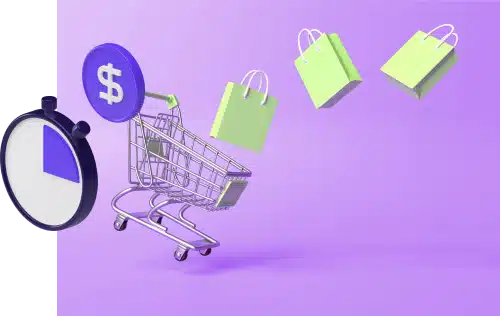Are you an artist looking to monetize your work? Do you want to know how to sell NFTs but still can’t understand the world of digital assets?
You’re not alone! Many artists and even collectors can struggle to understand the NFT market.
Luckily, in this tutorial, we’ll guide you through the NFT selling process. We’ll also provide similar investment ideas.
Why You Should Consider Selling NFT
Here are some of the benefits of selling NFT art:
- Value potential: Selling NFTs can be highly profitable. That has to do with scarcity. The digital art people sell is non-fungible, meaning no one else has the same product. As you know, the lower the supply of a product with high demand, the more it sells at a higher price.
- Unique ownership: Aside from money, NFTs provide full ownership autonomy for digital artists. Selling the one-of-a-kind NFT is the only way to lose this exclusive possession. That can be appealing to collectors.
- Easy to trade: Compared to physical assets, NFTs are easy to sell. All you do is list the digital asset in an NFT marketplace and wait for a potential buyer.
- Secure investment: Since NFTs are built on blockchain technology, they’re secure and tamper-proof. That’s because each NFT has a unique, unchangeable ID. Plus, each transaction is recorded on the blockchain.
Problems With Selling NFTs
While selling NFTs has many benefits, there are some challenges you should consider before investing in the former:
Price Volatility
The NFT market can be volatile, like other investments. A part of that has to do with evaluation challenges.
Sure, the NFT price depends on creativity, uniqueness, and demand. However, there isn’t a particular set of rules or fixed standards to evaluate the NFTs.
As a result, price fluctuations occur within a short period too!
For instance, the NFT market saw a 25% USD traded drop during the second quarter of the 2022 fiscal year. That can be problematic if you’re considering a long-term investment in the former business.
Cyber Threats and Online Fraud
While blockchain technology is relatively secure, NFTs aren’t scam-proof. You can still face several cyber threats and online fraud attempts. Some of the methods people use in NFT scams include wash trading.
The former involves creating a false high-demand appearance on a particular NFT. The NFT creator inflates the prices by buying and selling his product through multiple fake accounts. With each transaction, the fraudster increases the price to make the NFT appear valuable.
Another method scammers use is to sell fake NFTs. Unfortunately, you’ll have to take the loss since blockchain transactions are irreversible. And it doesn’t stop with fraud. Hackers use all sorts of phishing techniques or find their way to smart contracts, eventually stealing crypto.
Ethereum Based
Buying or selling NFTs is heavily tied to owning Ethereum (ETH). That’s because most of the popular NFT marketplaces, like OpenSea, use ETH as the core cryptocurrency. Sure, the former accepts other virtual currencies. Still, most of the transactions remain Ethereum-based.
Even if you’re not interested in NFT ownership, you’ll need to have cryptocurrency, typically ETH, in your digital wallet to sell your NFT collection. The former helps you with the NFT minting process.
Environmental Concerns
Creating, selling, and purchasing NFTs can harm the environment. That’s because blockchain technology is energy-intensive, leading to excessive amounts of carbon dioxide emissions.
Around 83 kg of carbon dioxide is emitted for each NFT added to the blockchain. At this rate, people need to plant millions of trees to counterbalance those harmful gases.
What You Will Need to Sell NFTs
To sell NFTs, you’ll need a few essentials. Those include:
- Digital asset: You can sell a purchased NFT or create a new digital asset. The former can be digital art, videos, tweets, and more.
- Marketplace account: All marketplaces require you to create an account on the platform to start selling NFTs. Before choosing a platform, make sure it supports the type of digital asset you want to sell.
- Crypto wallet: You’ll need a crypto wallet to make any transactions, including paying the gas fees and receiving payment.
Where to Sell NFTs
Several NFT marketplaces are available for selling your digital artwork. Some of the popular options include:
1. OpenSea Marketplace

OpenSea is probably one of the largest—if not the largest—NFT marketplaces. The former relies on the Ethereum blockchain. However, OpenSea accepts other cryptocurrencies such as SOL, BNB, AVAX, DAI, and USDC.
Aside from digital art, you can sell gaming NFTs, collectibles, or any digital asset backed by a blockchain.
- Fees/Commission: OpenSea charges a 2.5% transaction fee plus the gas fees.
- Payment method: Sellers receive the crypto in their connected wallet once they accept a transaction. The withdrawal process takes around 4 hours.
2. Solana Blockchain

Known as the Ethereum-killer, the Solana NFT marketplace offers several appealing perks. For one, it allows selling unlockable content. That means you can sell anything from PDFs to even physical collectibles.
Plus, the Solana blockchain has an impressive transaction speed of 65,000 transactions per second! Not to mention, it subtracts lower gas fees from your earnings.
- Fees/Commission: Solana NFT marketplace charges 2% on each successful sale.
- Payment method: Successful transactions will appear in your Solana Wallet connected to the NFT marketplace.
3. Binance

Binance NFT marketplace is another low-fee platform that allows you to list your NFTs and start selling. The former supports two blockchains: Ethereum (ETH) and Smart Chain (BSC).
One of the perks of using the former marketplace is that you can use the Binance cryptocurrency exchange. While you can’t directly buy NFTs using fiat money, you can easily convert the former to crypto on the application to purchase or sell non-fungible tokens.
- Fees/Commission: The platform takes 1% of the transaction fees for each successful NFT trade.
- Payment method: Sellers receive supported cryptocurrencies (BNB, ETH, BUSD, and MATIC) in their connected wallet.
How to Sell NFTs: Step-By-Step Instructions
Selling NFTs is a straightforward process, similar to selling traditional art on ArtFire or other alternatives.
All you do is apply the same steps to sell a product to selling NFTs. Here’s how:

Step 1: Create a Digital Asset
Before starting your NFT selling journey, you need to create your digital asset. The question is this: which non-fungible token should you create?
Digital artwork is the most popular type of NFT, with many buyers looking for collectibles. Other famous NFT types include gaming tokens, virtual real estate, memes, and digital fashion.
Some creators even sell tweets as NFTs! It all boils down to your preference and the field you’re skilled in.
Step 2: Get a Crypto Wallet
As you know, trading in an NFT marketplace requires cryptocurrency, even for selling. For that reason, you’ll need a crypto wallet to conduct any transaction on the NFT platform.
Here are some of the popular digital wallets available on the market and how to use them:
MetaMask Wallet
Whether you’re a seasoned crypto investor or a beginner, you’ll likely find MetaMask easy to use. The former is a cryptocurrency exclusive to Ethereum-based tokens. It enables users to connect to NFT marketplaces.
MetaMask is available for Android, iOS, and web browser extensions. The wallet offers services, such as buying, staking, swapping, and converting assets.
On the flip side, the wallet only supports Ethereum and not other popular cryptocurrencies, like Bitcoin. But the good news is that this wallet is suitable for selling NFTs since the former relies heavily on the Ethereum blockchain.
Here’s how to get started with MetaMask:
- Download the app from the app store.
- Click “Get Started.”
- Follow the prompts to either create a wallet or import an account.
- Back up your recovery phrase somewhere safe. If you lose the former, you won’t be able to recover your account.
Coinbase Wallet
Coinbase Wallet is another crypto wallet that you can download on your smartphone. It offers some cool features, like biometric authentication. Coinbase Wallet also has a built-in browser to explore different DApps, collect NFTs, and more.
Unlike MetaMask, the former supports various cryptocurrencies. That includes:
- Ethereum
- Bitcoin
- Polygon
- Dogecoin
- Solana
- Litecoin
- Ripple
- Stellar Lumens
Here’s how to use the Coinbase Wallet:
- Download the app from the Play Store.
- Choose “Create new wallet.”
- Create your password or biometric ID.
- Choose a username.
- Save your recovery phrase and you’re done!
Trust Wallet
For those looking for a secure, self-custodial mobile wallet, Trust Wallet might be a good option. The former is the official wallet for Binance after the former acquired it in 2018.
Aside from Ethereum-based tokens, you can use this wallet to store and transact other cryptocurrencies. Those include XRP and Bitcoin. You can also interact with various DApps through the app’s browser.
Here’s how to create an account on Trust Wallet:
- Open the app after downloading it from the Play Store or the website.
- Choose “Create Wallet.”
- Set your passcode.
- Save your backup phrase and click “Next.”
- Verify the backup phrases, and you’re done.
Step 3: Choose a Platform
Aside from the NFT platforms mentioned above, you’ve got plenty of other options to choose from. Those include Shopify, Rarible, and more.
Now, you might wonder: how do you choose a platform?
The primary features to look for in NFT selling platforms are reputation and security. A user-friendly interface, low transaction fees, and excellent support systems are also important qualities that you should consider.
Step 4: Evaluate Your NFT
Sure, NFTs don’t have an evaluation system; you can sell them for what people are willing to pay. A good place to start is by checking similar NFT prices. Don’t forget to add any fees and commissions to the total price.
That said, some factors can influence the final price. Those include:
- Uniqueness: The rarer your digital artwork is, the higher its price. For example, only 1% of the popular Bored Ape Yacht NFT collection has laser eyes. Those artworks sell for life-changing prices thanks to the rare trait.
- Utility: Attaching other perks to your NFTs can help you sell them for a higher price. Consider adding special privileges to your NFTs, like joining a particular club, giving discounts for future artwork, or offering ownership of a physical good.
- Average price: Another way to price your NFTs is to look at the 30-day average price history of similar tokens. Then, price your NFTs close to that average.
Step 5: List Your NFT
Once you’ve determined the price of your NFT art, all you need to do is list them in the marketplace and start selling! Now, each platform has its set of instructions.
However, generally, you’ll need to log into your account and click the “Create” button.
Then, choose between single or multiple collectibles, depending on the quantity of your NFT. Write the title and description of your digital artwork. The latter is a good place to enter rarity and utility details.
After entering all the information, choose between selling your NFT for a fixed price or an auction sale.
Things to Consider When Selling NFTs
Here are some extra things you should consider when selling NFTs:
You Can’t Mint NFTs on Different Platforms
For those who don’t know, minting is publishing your NFT on any blockchain for people to buy.
While you can offer your NFT on multiple platforms, you probably shouldn’t do so.
That’s because most platforms might delete your NFT or even ban you for good. You’ll still have the rights to your NFT. However, you won’t be able to sell it in the marketplace.
Legal Challenges
Although NFTs don’t have a legal definition, some countries, like Japan, have rules for regulating cryptocurrencies.
Investors can pay income taxes up to 55% on crypto in Japan. Other countries that regulate NFTs include Australia, Russia, and Switzerland. Some countries even ban crypto completely.
On that note, before investing in NFTs, make sure to check the laws in your country to avoid any legal consequences.
Frequently Asked Questions
How Much Does it Cost to Sell an NFT?
The price of selling NFTs depends on the marketplace you choose. Most platforms charge between 2% and 2.5% of the NFT price once the transaction is completed. Plus, you’ll have to pay a gas fee to list your digital asset, which fluctuates depending on supply and demand.
Can Anyone Just Sell an NFT?
Yes, anyone can sell NFT if they own the digital asset and can access a blockchain. However, some countries ban NFTs and crypto trades. In that case, you can’t invest in non-fungible tokens, as it can be illegal.
Similar Tutorials to Check Out
Looking for other investment ideas? Here are some similar tutorials for you to check out:
- How to Sell on Crypto.com: To sell on Crypto.com, you’ll need to create an account and log in. Navigate to the market page, choose the one you like, and select the coin you want to sell. Once you’re satisfied with the value, press sell.
- How to Sell Dogcoing on Robinhood: Open the application and search for the cryptocurrency you have. Tap sell, enter the quantity, and follow the prompts to confirm the process.
- How to Sell NFT on Opensea: On the website, click on your profile icon. From the website, select the NFT you want to list, click Sell, and choose the type of sale.
Wrapping Up
Selling non-fungible tokens can be a great investment. All you do is figure out how to sell NFTs.
Luckily, the process is straightforward and only requires creating an account in the marketplace. You’ll also need a digital wallet with crypto in it.
By applying the steps in this guide, you can start selling NFTs and earn money! If we still haven’t answered some of your questions, let us know in the comment section below!









